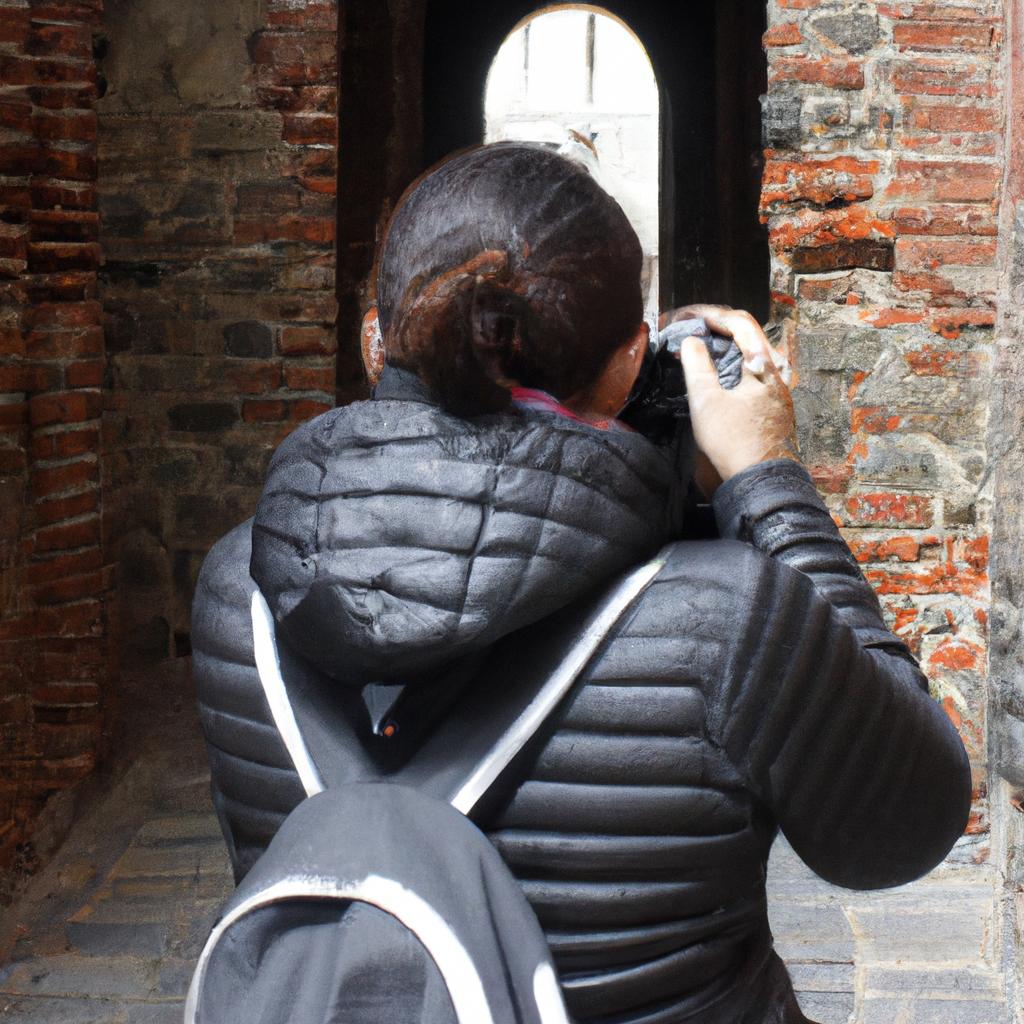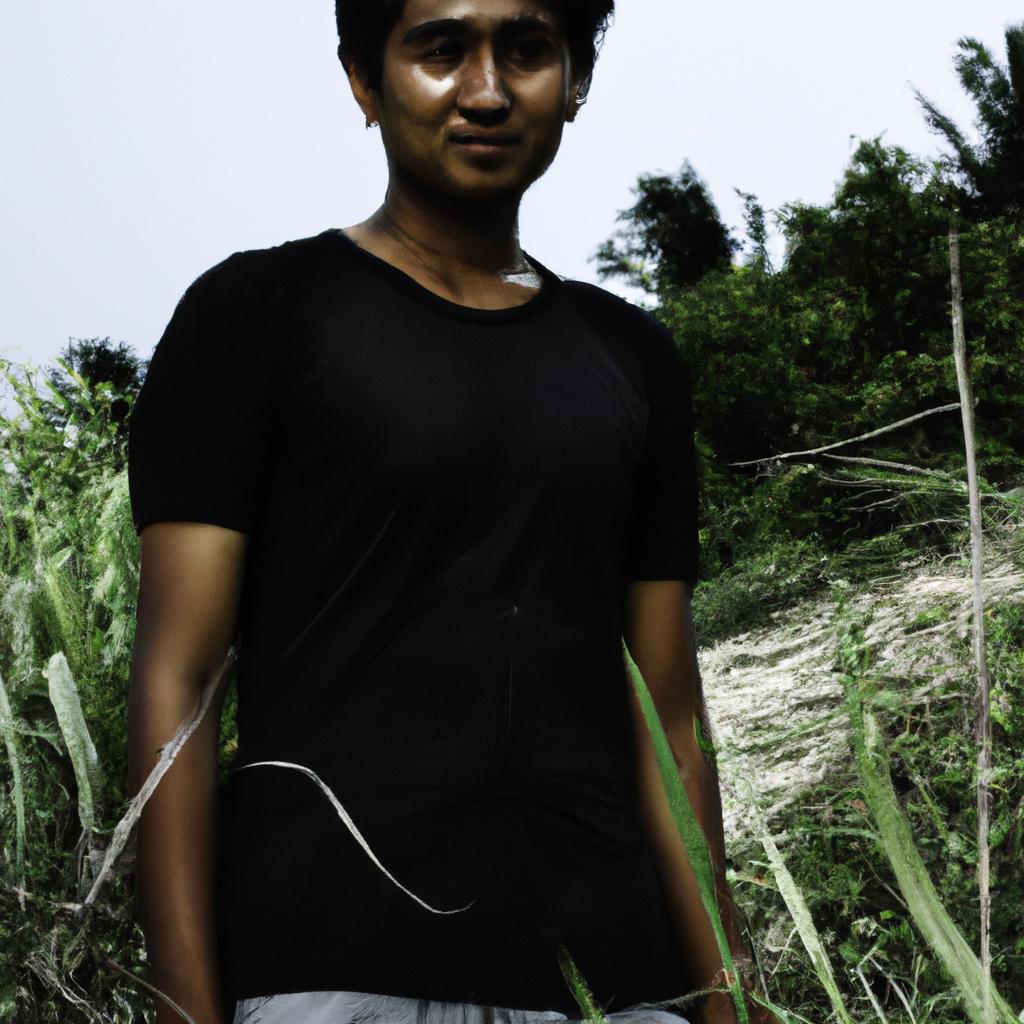Street photography has long been celebrated as a captivating form of visual storytelling that captures the essence and energy of everyday life. This genre of photography, characterized by its spontaneous and unposed nature, draws inspiration from various artistic mediums, including movies. The intersection between street photography and cinema offers a unique opportunity to explore the symbiotic relationship between these two art forms, where one informs and inspires the other. For instance, consider the case study of renowned street photographer Vivian Maier, whose incredible body of work was discovered posthumously in 2007. Through her photographs, Maier not only documented ordinary moments on the streets but also created narrative-like compositions reminiscent of cinematic scenes.
The connection between street photography and movies can be attributed to their shared objective: to convey stories through visuals. Both art forms rely heavily on composition, lighting, framing, and timing to evoke emotions and engage viewers. Street photographers often employ techniques similar to those used in filmmaking such as capturing decisive moments or creating visual narratives within a single frame. Additionally, both street photography and cinema possess an inherent sense of authenticity as they capture real-life situations and individuals encountered in public spaces. This juxtaposition blurs the line between reality and fiction, leaving room for interpretation and inviting audiences to contemplate the complexities and contradictions of the human experience.
The influence of cinema on street photography can be observed in various ways. For instance, certain photographers may draw inspiration from iconic cinematography techniques, such as using long shots to capture a sense of place or employing close-ups to emphasize the emotions of their subjects. Similarly, the use of light and shadows in film noir can inspire street photographers to experiment with dramatic lighting conditions to create atmosphere and mood in their images.
Conversely, street photography also has the potential to inspire filmmakers. The raw and unfiltered nature of street photographs can serve as visual references for directors, helping them to recreate authentic urban settings or incorporate realistic depictions of everyday life into their films. By observing how street photographers capture candid moments or frame scenes within the chaos of city streets, filmmakers can gain insights into storytelling techniques that add depth and richness to their narratives.
Ultimately, the connection between street photography and cinema is rooted in their shared goal of capturing moments that resonate with viewers. Whether through a single still image or a moving sequence on screen, both art forms have the power to transport us into different worlds, evoke emotions, and ignite our imaginations. By exploring this intersection between street photography and movies, we not only deepen our appreciation for these art forms individually but also uncover new possibilities for creative expression that arise when they converge.
History of street photography
Street photography has a rich history that spans several decades and is deeply rooted in the intersection of arts and movies. This genre captures candid moments of everyday life, often taken on the streets or in public places, providing a glimpse into the raw essence of urban existence. To understand its origins, we must explore how street photography evolved over time.
In the early 20th century, pioneers like Eugene Atget and Henri Cartier-Bresson laid the foundation for street photography as we know it today. Their work focused on documenting cityscapes and people’s lives with an artistic eye. For instance, imagine a bustling Parisian street captured by Cartier-Bresson’s Leica camera – frozen in time yet brimming with energy. These photographs not only showcased technical skill but also encapsulated human emotions within fleeting moments.
As society progressed, so did street photography. In the mid-20th century, photographers such as Robert Frank and Garry Winogrand employed this medium to critique societal norms and capture cultural shifts amidst changing landscapes. The emotional impact of their images cannot be understated – they revealed both beauty and harsh realities through compelling compositions that stirred viewers’ hearts.
To illustrate further, consider these examples:
- A lone figure standing at a deserted bus stop under dimly lit street lamps evokes feelings of solitude.
- Vibrant colors juxtaposed against decaying buildings elicit a sense of hope amidst urban decay.
- An elderly couple holding hands while crossing a busy intersection conveys enduring love amidst chaos.
- A child chasing pigeons in a park represents innocence untainted by adult worries.
This emotional response can also be depicted using a table format:
| Emotion | Example |
|---|---|
| Solitude | Lone figure at deserted bus stop |
| Hope | Vibrant colors against decaying buildings |
| Love | Elderly couple crossing busy intersection holding hands |
| Innocence | Child chasing pigeons in a park |
In conclusion, the history of street photography is deeply intertwined with the evolution of art and movies. Through its ability to capture candid moments and evoke emotional responses, this genre continues to captivate viewers even today. In the subsequent section, we will explore some influential street photographers who have left an indelible mark on this artistic medium.
Influential street photographers
Intersection of Arts and Movies in Street Photography
The captivating nature of street photography lies not only in its ability to freeze a moment in time but also in its unique connection with the arts and movies. By capturing candid moments from everyday life, street photographers often create visual narratives that resonate with viewers on an emotional level. This section explores how street photography intersects with the realms of art and cinema, highlighting the various techniques employed by photographers to evoke powerful emotions.
To illustrate this intersection, let’s consider a hypothetical example: imagine a street photograph taken at dusk, where the silhouette of a lone figure is cast against vibrant city lights. The composition evokes feelings of solitude and introspection, reminiscent of film noir aesthetics. Through careful framing and lighting choices, the photographer effectively merges elements of cinematic storytelling into their artistic work.
In street photography, several techniques are commonly used to elicit emotional responses from viewers:
- Contrast: Playing with light and shadow can enhance dramatic effect within an image, accentuating certain elements or creating a sense of mystery.
- Composition: Thoughtful placement of subjects within the frame can establish visual harmony or tension, guiding the viewer’s gaze and conveying specific moods.
- Timing: Capturing decisive moments when people interact or exhibit genuine expressions adds depth to photographs, inviting viewers to empathize with the depicted scene.
- Color grading: Manipulating colors during post-processing allows photographers to imbue images with distinct atmospheres and convey particular emotions.
Furthermore, it is interesting to note some similarities between street photography and filmmaking. Both mediums involve crafting narratives through visuals, utilizing different angles, perspectives, and focal lengths for impactful storytelling. Additionally, just as filmmakers carefully select locations for their scenes, street photographers seek out environments that reflect social issues or cultural dynamics they aim to capture.
Through these intersecting aspects between arts and movies, street photography has become more than mere documentation – it has evolved into a form of creative expression capable of provoking introspection, empathy, and a sense of connection with the human experience.
Transitioning seamlessly into the subsequent section about “Techniques and styles in street photography,” we delve deeper into the specific methods employed by photographers to capture compelling moments on the streets.
Techniques and styles in street photography
Street photography is a captivating form of visual art that has deep connections with the world of movies. By capturing candid moments in public spaces, street photographers have been able to create evocative and thought-provoking images that resonate with viewers. In this section, we will explore some influential street photographers and their impact on both the art world and cinema.
One notable example is Vivian Maier, an American street photographer whose work was discovered posthumously. Maier’s photographs offer a unique perspective on everyday life, showcasing raw emotions and compelling narratives within ordinary settings. Her ability to capture fleeting moments drew attention from both art enthusiasts and filmmakers alike.
To illustrate how street photography intersects with movies, let us consider four key aspects:
- Storytelling: Street photographs often tell stories by capturing slices of life in a single frame. These images can evoke strong emotions and prompt viewers to imagine the broader narrative behind them.
- Cinematic composition: Many street photographers employ compositional techniques similar to those used in filmmaking, such as framing subjects within architectural elements or incorporating leading lines to guide the viewer’s gaze.
- Mood and atmosphere: Street photographs possess a certain mood or atmosphere that can transport viewers into different worlds or time periods, much like films do through set design, lighting, and color grading.
- Character studies: Just like characters in movies, individuals captured in street photographs become protagonists who invite curiosity about their lives and experiences.
To further understand these intersections between street photography and movies, consider the following table:
| Aspect | Street Photography | Cinema |
|---|---|---|
| Visual storytelling | Captures snippets of daily life | Presents narratives through moving images |
| Composition | Utilizes various framing techniques | Employs cinematography rules for effective visuals |
| Mood/Atmosphere | Evokes emotions through still frames | Creates ambiance through lighting, color grading, and set design |
| Character studies | Focuses on individuals in public spaces | Develops complex characters through acting |
Street photography’s connection to cinema is undeniable. By employing similar techniques and evoking comparable emotions and narratives, street photographers have influenced the visual language of movies. In the subsequent section, we will delve into how cinema has embraced street photography as a source of inspiration and explore its impact on filmmaking aesthetics.
Street photography in the context of cinema
Transitioning from exploring the techniques and styles utilized in street photography, we now delve into its intersection with cinema. This dynamic relationship between two visual art forms has seen street photography influence and be influenced by various cinematic elements. One such example can be found in the work of renowned photographer Henri Cartier-Bresson, whose candid captures on the streets of Paris echoed the aesthetics and storytelling techniques employed in French New Wave films.
The connection between street photography and cinema is further evident when considering their shared focus on capturing authentic moments. Both mediums aim to document reality as it unfolds, often relying on spontaneity rather than staged scenes. The use of natural lighting, unscripted subjects, and genuine emotions enhances the sense of realism conveyed through both photographic stills and moving images.
To illustrate this point more vividly, here are a few key aspects that highlight the convergence between street photography and cinema:
- Composition: Just like filmmakers carefully frame each shot within a movie scene, street photographers strategically compose their images to convey meaning or evoke certain emotions.
- Narrative: While individual photographs may not tell an entire story by themselves, they possess the power to capture a moment that sparks curiosity or prompts viewers to imagine what happened before or after.
- Mood: Both street photography and movies have the ability to transport audiences to different atmospheres through their use of light, shadow, color grading (in film), or post-processing techniques (in photography).
- Emotion: Whether it’s a fleeting expression captured in a photograph or an actor conveying deep emotion on screen, both mediums excel at evoking strong emotional responses from viewers.
Considering these similarities, it becomes evident how street photography borrows from cinematic language while also influencing contemporary filmmaking practices. By embracing spontaneous moments and authentically documenting human experiences in public spaces, both art forms contribute to our collective understanding of society.
Continuing the exploration of street photography’s role as a form of storytelling, we now delve into its capacity to capture narratives that resonate with viewers on a personal level.
Street photography as a form of storytelling
Street photography, beyond its visual aesthetics and technical mastery, serves as a powerful storytelling tool that captures the essence of everyday life. By freezing seemingly ordinary moments in time, street photographers are able to convey narratives that resonate with viewers on both intellectual and emotional levels.
One example of this is Henri Cartier-Bresson’s iconic photograph “Behind the Gare Saint-Lazare.” In this image, Cartier-Bresson captured a man leaping over a puddle behind a train station. While simple at first glance, the photograph tells a story of determination, risk-taking, and resilience. It prompts viewers to contemplate themes such as urban exploration, personal obstacles overcome, and the pursuit of one’s goals despite adversity.
To further understand how street photography becomes a medium for storytelling, consider the following aspects:
- Candid Moments: Street photographs often capture unguarded moments that reveal authentic emotions and human connections.
- Environmental Context: The surrounding environment contributes to the narrative by providing clues about social dynamics or cultural nuances.
- Serendipity: Chance encounters and unexpected juxtapositions add an element of surprise and intrigue to street photographs.
- Universal Themes: Street photography explores universal human experiences such as love, loneliness, joy, struggle, and hope.
The power of street photography in conveying stories can be best exemplified through the use of visual elements. The table below showcases four key components utilized by street photographers to create compelling narratives:
| Visual Element | Description | Emotional Impact |
|---|---|---|
| Composition | Balancing elements within the frame | Aesthetic pleasure |
| Light | Manipulating light conditions for dramatic effect | Evoke mood or atmosphere |
| Gesture | Capturing body language and expressions | Convey emotion or intention |
| Decisive Moment | Timing shots to capture fleeting yet meaningful instants | Create tension or anticipation |
In summary, street photography is a form of storytelling that goes beyond the surface level. Through candid moments, environmental context, and serendipity, it invites viewers to immerse themselves in narratives that explore universal themes. By effectively utilizing visual elements like composition, light, gesture, and the decisive moment, street photographers craft compelling stories that evoke emotional responses from their audience.
As we delve deeper into the impact of street photography on popular culture, we will examine how this art form has influenced various aspects of our society.
Impact of street photography on popular culture
Transitioning seamlessly from the previous section, where street photography was explored as a form of storytelling, we now delve into its profound impact on popular culture. Street photography has become more than just an art; it has evolved into a medium that intersects with movies and influences our collective imagination. To illustrate this point, let’s consider a hypothetical scenario:
Imagine a bustling city street filled with people going about their daily lives. A photographer captures a candid moment of an elderly couple holding hands while walking through the vibrant crowd. This photograph tells a story of love enduring amidst the chaos of urban life. Now envision this image being transformed into a poignant scene in a movie – the camera panning across the couple, capturing their wrinkled hands intertwined against the backdrop of busy streets, accompanied by melancholic music. Such an evocative portrayal would strike a chord with viewers and leave an indelible impression.
The impact of street photography on popular culture can be attributed to several factors:
- Authenticity: Street photographs capture genuine moments that reflect reality, making them relatable to audiences who yearn for authenticity in media.
- Emotional resonance: These images often evoke strong emotions by immortalizing fleeting instances or conveying societal issues through visual narrative.
- Provoking thought: Street photographs compel viewers to contemplate various aspects of human existence and ponder upon social dynamics captured within each frame.
- Cultural documentation: By documenting different communities, cultures, and subcultures around the world, street photography serves as a valuable historical record.
To further emphasize the influence of street photography on popular culture, we present below a table showcasing notable examples where iconic street photographs have transcended their original context and made an impactful appearance in various forms of media:
| Photograph | Media Appearance | Impact |
|---|---|---|
| “V-J Day in Times Square” by Alfred Eisenstaedt | Poster for the movie “The Notebook” (2004) | Iconic representation of love and celebration |
| “Children Playing in a Yard, Harlem” by Helen Levitt | Opening credits sequence for the TV series “The Wire” (2002-2008) | Depiction of urban life and societal disparities |
| “Lunch atop a Skyscraper” by Charles C. Ebbets | Inspiration for scenes in movies like “Spider-Man” (2002) and “The Adjustment Bureau” (2011) | Symbolism of bravery and human resilience |
In summary, street photography has transcended the realm of art to become an influential force within popular culture. Its ability to capture authentic moments, evoke emotions, provoke thought, and document diverse cultures have made it a catalyst that intersects seamlessly with various forms of media such as movies and television. Through these collaborations, street photographs continue to resonate with audiences on both aesthetic and emotional levels, leaving an enduring impact on our collective imagination.




